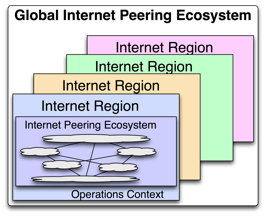While the commercial Internet has grown organically, it has developed with a consistent and identifiable structure. This structure can best be described as the Global Internet Peering Ecosystem.
Definition: The Global Internet Peering Ecosystem is the set of loosely coupled Internet Regions, each of which contains an autonomous Internet Peering Ecosystem.
Let’s walk through the Global Internet Peering Ecosystem model shown in the figure below.

Figure.The Global Internet Peering Ecosystem model.
Definition: An Internet Region is a portion of the Internet contained within the boundaries of a country.
Each Internet Region presents a different operations context to the ISP offering services there. An Internet Region will have different:
For example, some Internet Regions like Singapore are small enough that all traffic can be exchanged at a single IXP. Other Internet Regions like the U.S. have large amounts of traffic to distribute across a geographically vast area. Many interconnect regions are required there.
These are just a few areas where Internet Regions differ. The Internet Region abstraction allows us to compartmentalize the operational context in which ISPs need to operate if they wish to participate in the Internet Peering Ecosystem there.